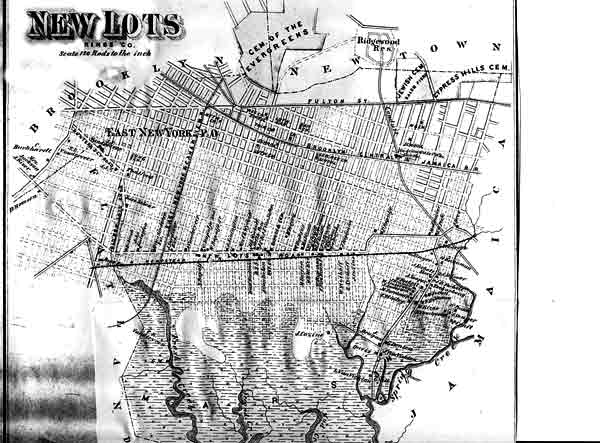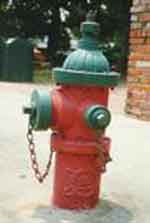

229 the first sprawl age
The most provocative and useful idea in design from all the new cities
founded on America's frontier happened more or less by accident.
For some 170 years it managed to survive, again more or less by accident. In
the 60's, some of our cleverest minds in planning and urban renewal
combined to trash it. Next time you're in Pittsburgh, take a stroll
over to the North Side to see what's left.
They couldn't find any better name for this neighborhood than 'New Lots'. And no one has yet, well over a century since this 1873 plat map was made to entice New York speculators out to the suburban frontier in Brooklyn. Block after block after block of new lots, extending, hopefully, even into the swamps of Jamaica Bay. There is something uniquely chilling about this plan; it seems to reduce all the cleverness and rationality of man to a macabre joke. Planning could never sink lower. Not surprisingly, New Lots and the adjacent East New York have become one of the grayest, most dismal slums in all of New York City. Not everything built in the post-Civil War decades was quite this awful. But the New Lots plan is here to give you an idea of the scale of America's first age of suburban sprawl. It's easy to see from the map that New Lots was planned for a much higher density than the sprawl of today. The area covered by new development will always be proportional to the speed of people's common mode of transport, and in this era that meant horse cars and elevated trains. The sprawl of the 1870's sprawl was as amazing a phenomenon, to people of that age, as anything we see today. Cities grew to an extent unimaginable a half-century before. By 1900 Brooklyn's built up area covered over 50 square miles. The built up area of Boston in 1850 could be contained within a circle of a radius of two or three miles. Only 50 years later, the radius would be ten miles. In wartime, when men are away and money for personal desires is scarce, building takes a nap. War's end brings a rush to make up for lost time. It was as true after the Civil War as after World War II, and if the new mass-produced subdivisions of the 1870's were sometimes of extremely low quality in both design and architecture, Americans of that era didn't much complain. Cultural criticism, in those days, was still a novelty. In New York, the first big boom came immediately after the war, on both the east and west sides of Central Park; at the same time West Philadelphia began to turn from farm fields to row houses. Chicago sprawled out in all directions. America after World War II had Bill Levitt and his Levittowns, but Chicago after the Civil War produced his original. Samuel Eberly Gross built 7000 houses in the 1880's alone, from classic Chicago cottages, advertised as 'The Working Man's Reward', to more pretentious middle class homes. Developers like Gross marketed a suburban dream that included all the modern conveniences—not yet built-in kitchens and electric washers, but indoor 'bathing rooms' and flush toilets, an iron double washtub in the cellar and maybe even central heating. The other essential amenity, especially in the Midwest, was a front porch. Tiny porchlets even crept on to the fronts of Philadelphia rowhouses, though in Baltimore, for a while yet, all the workingman asked was a marble stoop. America was slowly learning about its slum problem, but the singular development of this era was the nation's new talent for creating new ones: purpose-built slums, communities that were doomed from their birth. Most of these suburban toadstool developments, like New Lots or Gross's subdivisions on Chicago's South Side, grew up where a wave of speculative development totally outran a city's will and ability to control it. The very worst side of this phenomenon could be seen in New York. A previous generation had built doomed neighborhoods on the lower East Side, and its sons would repeat the process on a grand scale in Brooklyn, where new horsecar lines opened up dozens of square miles after the Civil War. The 'veterans' champion', Brooklyn's biggest developer, was Charles S. Brown, who owned vast tracts of land in the rural eastern half of the city. The woebegone Brownsville neighborhood is named for him; he started the housing boom there in 1867. Brown's formula was cheap houses, and mortgages for the workingman with liberal repayment terms—too liberal perhaps, for Brown eventually went bust and had to flee the country. A realtor named Aaron Kaplan picked up the pieces, and made a fortune by luring garment firms from the Lower East Side with cheap land, and then building housing for their mostly Jewish workers. By 1890 the els and street lines reached to the limits of the city; Brownsville, Bushwick and East New York were all booming. Instead of single-family workingmens' homes though, they were filling up with tenements, and Brownsville in particular began to look very much like the Lower East Side that the first pioneers were trying to escape. Nowhere in America, except perhaps in Philadelphia, were neighborhoods built so poorly. The grids rambled on for mile after mile, with no squares, few trees or parks, few amenities of any kind. For the Jews, such a place was never more than a rung on the ladder: 'If God is good, a Brownsvillian moves to Eastern Parkway'. By the 30's they had handed down parts of it to the Italians, who didn't care to stay either, and most of this end of Brooklyn went black after World War II; no matter who was living there, it would have become the same dry tinder for the disinvestment and massive abandonment that hit it in the 70's. There's a puzzle hiding here, a nasty dilemma of city-building. In the days of Gross and Brown, America knew how to develop affordable housing—for all its fatal flaws, that's what New Lots was all about. Nowadays, zoning and other land-use regulation makes building new affordable housing impossible in suburban areas, and it's becoming increasingly clear that reforming or eliminating zoning is the most immediate job our cities face. But once we slay the beast—once we finally do away with the zoning ordinances and building and housing codes that mandate one-class neighborhoods and government-decreed social segregation—how can we be sure that New Lots doesn't rise up out of the grave once more? |
|

|